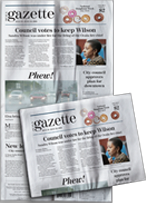A trove of treasures unearthed
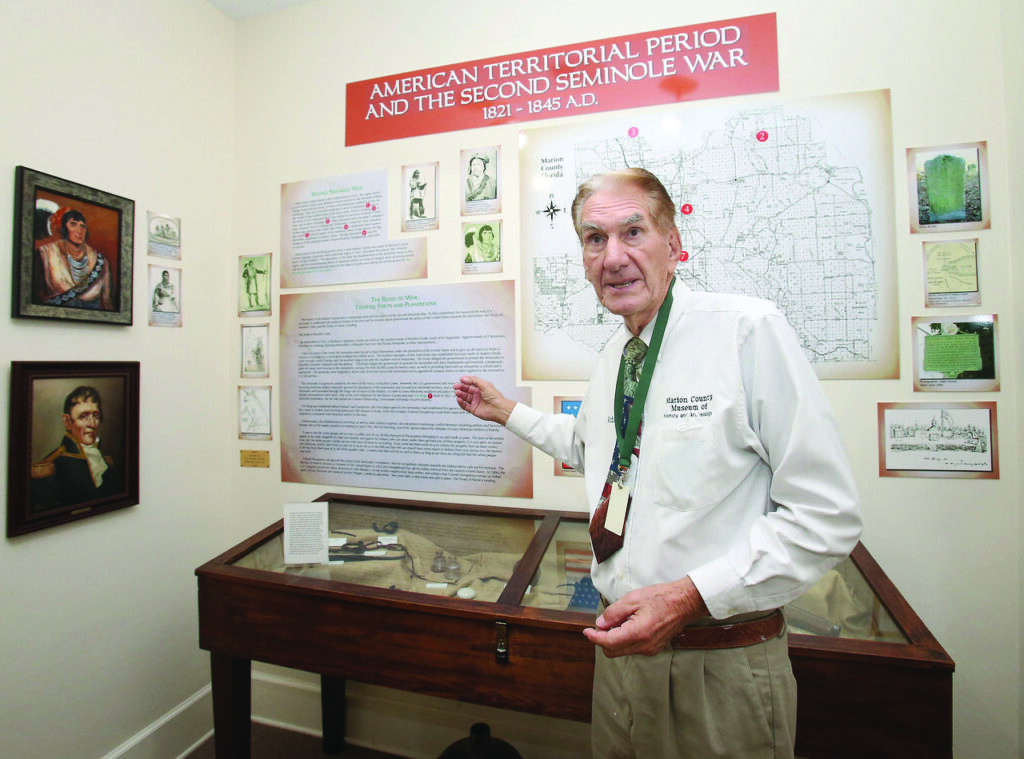
Richard Cardinali, a museum trustee, talks about an exhibit on the American Territorial Period and the Second Seminole War at the Marion County Museum of History and Archaeology in the McPherson Governmental Complex on Tuesday, Sept. 15, 2020. The museum is open to the public during the week and on Saturdays and tours will frequently be given. The admission fee is $3. [Bruce Ackerman/Ocala Gazette] 2020.
The people and events that shaped the area come to life at the Marion County Museum of History

Richard Cardinali, a museum trustee, talks about an exhibit on the American Territorial Period and the Second Seminole War at the Marion County Museum of History and Archaeology in the McPherson Governmental Complex on Tuesday, Sept. 15, 2020. The museum is open to the public during the week and on Saturdays and tours will frequently be given. The admission fee is $3. [Bruce Ackerman/Ocala Gazette] 2020.
Historical artifacts provide insight into our past, fueling our imagination with images of previous eras.
Archivists and chroniclers who understand the importance of the past are able to demonstrate the significance of previous times, as are collectors, who painstakingly acquire artifacts to add depth and volume to collections that narrate the past.
The Marion County Museum of History and Archaeology recently acquired several collections and items that help tell the story of people and events that shaped the area.
One of those collections centers around an Ocala resident, Louis Dosh, a West Point graduate, and the oldest son of Bert Dosh, the former editor of the Ocala Star-Banner. His is a story of love, passion and sacrifice.
“Bert Dosh had four boys and one girl,” said Price Landrum, Marion County Museum of History and Archaeology board of trust president. “All four boys went into the Army, and three of them went to West Point … the day he graduated the Point, he married Betty (who was a Ford Modeling Agency model).”
However, Dosh had the misfortune of being in the Philippines when that nation fell. He was able to escape the ensuing death march and was engaged in guerilla activity in the jungles for two years, eventually surrendering to the Japanese when his health took a turn for the worse, said Landrum.
“He was in a prisoner of war camp for a while, and then was put on one of the hell ships, which was bombed by the U.S. Navy. He was taken ashore, put back onto another hell ship, and then died and was buried at sea.”
It was at about the time of Dosh’s death, that his wife Betty christened the S.S. Ocala Victory, without knowing the fate of her husband, said Landrum.
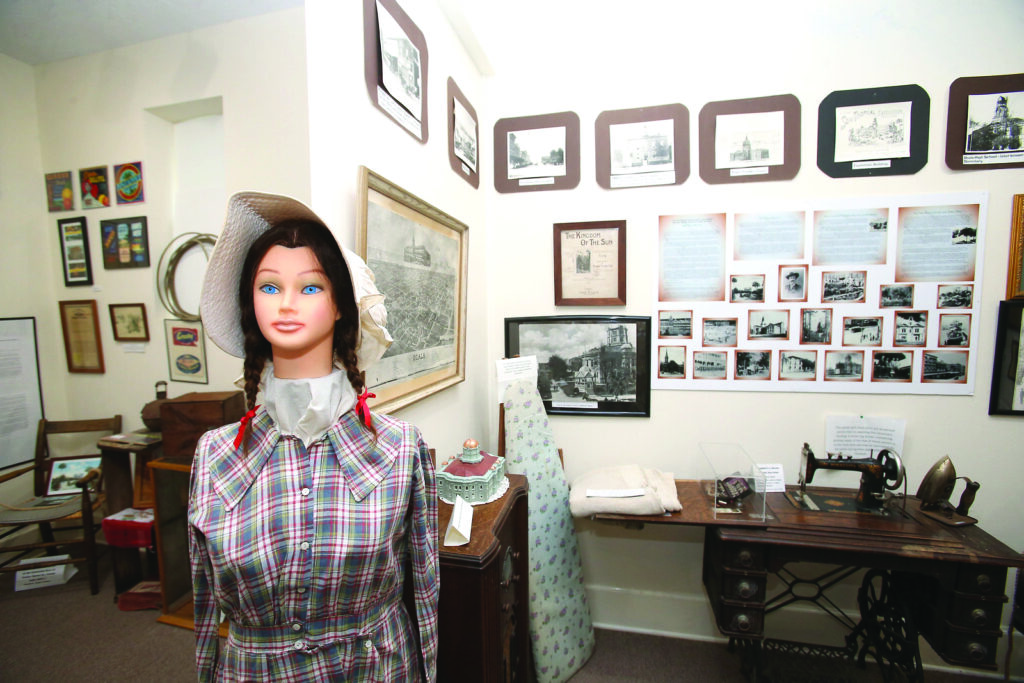
An exhibit showing photographs and items from Marion County is shown at the Marion County Museum of History and Archaeology in the McPherson Governmental Complex on Tuesday, Sept. 15, 2020. The museum is open to the public during the week and on Saturdays and tours will frequently be given. The admission fee is $3. [Bruce Ackerman/Ocala Gazette] 2020.
“At that time, they thought he was still a prisoner of war,” said Landrum. “They had gotten two cards from him as a prisoner of war. The amount of war bonds sold in Marion County and the fact that he was a prisoner of war, were among the reasons that it (military watercraft) was named the S.S. Ocala Victory. They didn’t find out that he had died until the Americans had reconquered the Philippines.”
Betty, Louis’ widow, received not only the bottle from the shipping company, but a box with her name on it, said Landrum. She also received two pieces of jewelry and a photograph album. However, the story of Louis and Betty Dosh was immortalized globally when their nuptials appeared in one of the most widely acclaimed periodicals of the time.
“Their wedding was the cover story of Life Magazine, a month after they got married,” said Landrum. “We have a Purple Heart that she got in 1945. In 2011, Senator Nelson got Louis’ medals for Louis’ brother, who was still alive in January. He was going to get his daughter-in-law to bring us the rest of his medals, and then COVID hit. I’ve been afraid of trying to call him because I don’t want to hear that his phone has been disconnected, and we came that close to meeting Louis’ brother.”
One of Louis’ grand-nephews is an Ocala resident, said Landrum. The family has a deep history with the area, with one of his other brothers having worked for Barnett Bank for time.
In addition to the aforementioned items, the museum has photo albums, drawings and a scrap book Louis made for Betty of West Point, said Landrum.
“The family put a memorial headstone up for him here in town,” said Landrum. “He’s on one, maybe two, memorials up at West Point. We have a photograph of the memorial; we’re not sure of where it is, but It looks as if it’s at West Point. His house is still standing in the historic district.”
Louis Dosh aspired to be an opera singer, said Landrum. He was in the glee club at both Ocala High School and West Point.
“He wrote poetry, and when he was 17, he wrote a poem about giant redbirds bringing death out of the sky,” said Landrum. “In one of his last letters home to his mother before the war started, he wrote to her that he wasn’t afraid to die.”
The romance between Louis and Betty was like many others, in that the war disrupted and transformed their lives, ultimately changing the course of their relationship.
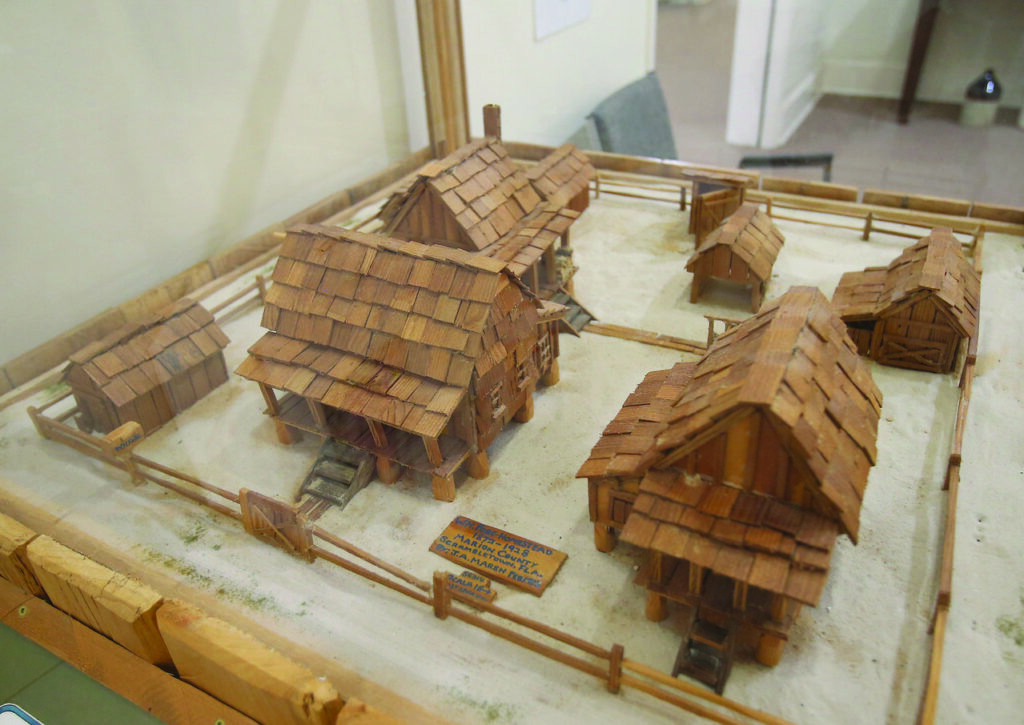
A scale model of the W.H. Fore Homestead in Scrambletown (1872-1928) constructed by John A. Marsh, the grandson of Mr. Fore, is shown at the Marion County Museum of History and Archaeology in the McPherson Governmental Complex on Tuesday, Sept. 15, 2020. The museum is open to the public during the week and on Saturdays and tours will frequently be given. The admission fee is $3. [Bruce Ackerman/Ocala Gazette] 2020.
“I know there were a lot of people who had just gotten married, who ended up being separated during the war. On paper they were married for six years, but they got separated after three and never saw each other again,” said Landrum. “Betty went with him to the Philippines but was evacuated before the war started.”
The museum recently featured an exhibit of an area in Marion County that had a significant economic impact.
“We had a beautiful revolving display about Marti City, featuring the cigar labels on the boxes, that were pieces of artwork,” said Judy Delk, Marion County Historical Society board of trustees. “We have a pretty banner featuring a bunch of those from Marti City, which was a Cuban community of cigar makers, outside of the city limits, and there were seven factories here and they grew tobacco here.”
The museum was also the recent recipient of 640 artifacts, with many of them being traced back to an individual who wore multiple hats while serving the citizens of Marion County.
“There was a guy named Cromartie, who was both the mayor of Reddick and a justice of the peace for the county,” said Landrum. “And until we got this stuff, I had never realized there had been justices of the peace in Marion County.”
Many of the artifacts are legal papers from Cromartie’s time while serving as a justice of the peace, according to Landrum.
“We have arrest warrants for various crimes dating back into the 1930s and 1920s,” said Landrum.
The museum also boasts an impressive genealogical section, said Delk.
“We had 600 items that were just donated by a local historian and genealogist, Hoyalene Thomas, and her specialty is in early Marion County,” said Delk. “She’s a member of our board of trustees. She has spent 40 plus years doing research and genealogy of the old surveys and communities.”
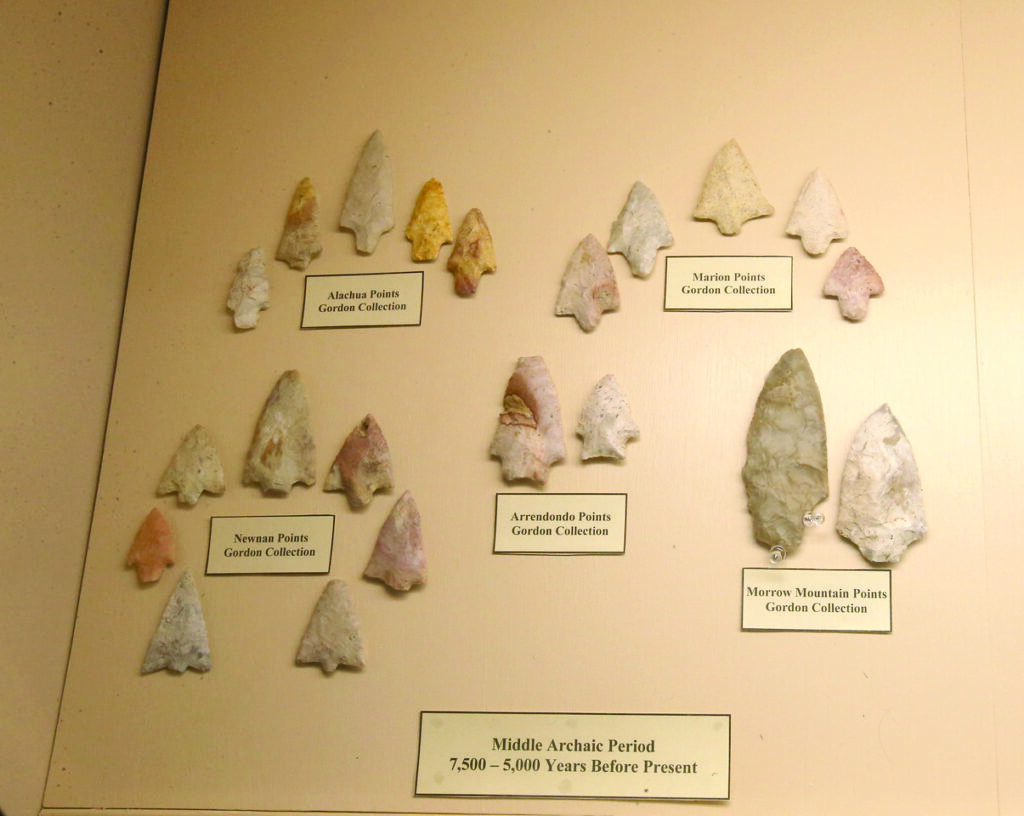
Indian arrowheads are shown at the Marion County Museum of History and Archaeology in the McPherson Governmental Complex on Tuesday, Sept. 15, 2020. The museum is open to the public during the week and on Saturdays and tours will frequently be given. The admission fee is $3. [Bruce Ackerman/Ocala Gazette] 2020.
Also in the museum’s possession is a Marion County map from 1892 that had been produced by a familiar name on the local landscape, Moorhead Engineering.
“Mr. Moorhead was the county engineer, and Moorhead still sells a replica of that map, but we have the original one on display,” said Landrum. “It shows all of the post offices and schools in the county. In the 1890s, if you lived in one of the rural areas, they did not deliver your mail to you; you had to go into the post office to pick it up, and that’s why there were so many post offices in the county.”
A recently retired insurance agent gifted a collection of Sanborn Insurance maps to the museum, and they took on added meaning for Landrum.
“They showed all the buildings in the community,” said Landrum. “The one that he gave us was the 1930 one, updated to 1965, and the way it was updated, you can put your phone light underneath a page and see the building that was there before, and it has my grandparents’ house in it. That was just kind of mind blowing.”
Legal documents and maps weren’t the only paperwork to take up permanent residence at the museum recently.
“We had a lady contact us by email, and she said that her father always wanted to come and live in Marion County,” said Landrum. “He collected brochures and she asked if we wanted them. I was expecting a manila envelope with some tri-fold brochures like we used to write away for when I was a kid and we had to plan a trip. We would write to the chamber of commerce as a school project.”
When the package did arrive at the museum, it contained 183 items, with certain pieces dating back to the earlier part of the 20th Century, said Landrum. The Eighth Street Elementary School building that was constructed in 1914 hadn’t been built yet, and the box contained a conceptual drawing and images that the board at the museum had never seen before.
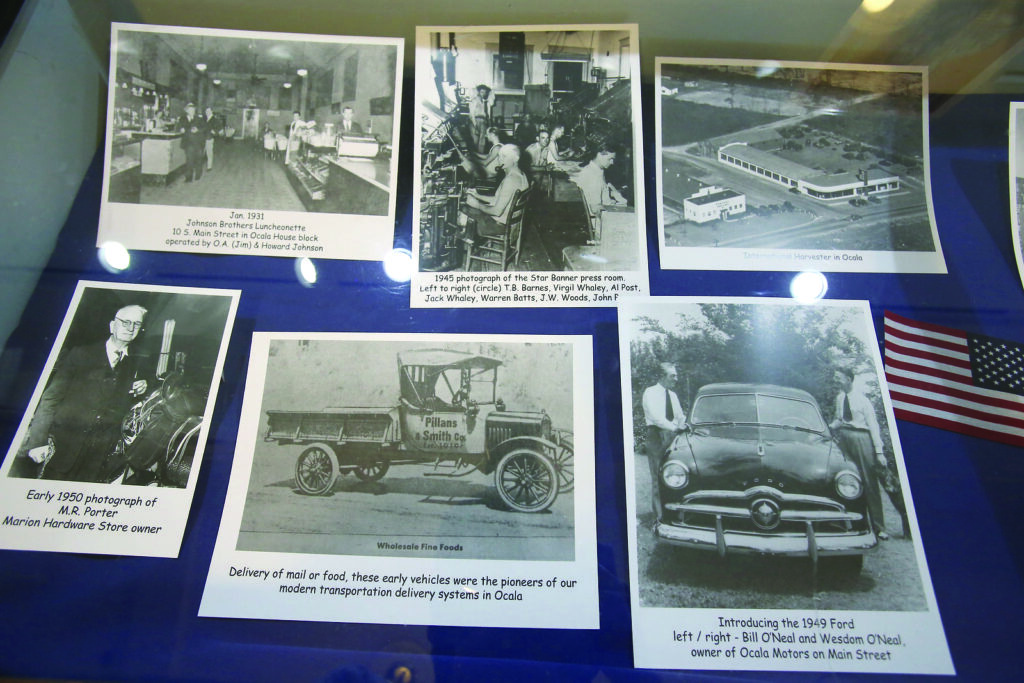
Historical photographs of Ocala and Marion County are shown on display at the Marion County Museum of History and Archaeology in the McPherson Governmental Complex on Tuesday, Sept. 15, 2020. The museum is open to the public during the week and on Saturdays and tours will frequently be given. The admission fee is $3. [Bruce Ackerman/Ocala Gazette] 2020.
A propitious surprise happened one Saturday, when a man walked into the museum with a box, and explained that his father-in-law had lived in Ocala. The donation was far more than just society columns. His father-in-law’s ancestors played a big role in conducting business in the area during the late 19th Century, said Landrum.
“Marion County had a thriving black middle class, and a lot of the brick buildings downtown were built by these black entrepreneurs,” said Landrum. “Some of the paperwork from the wheeler and dealt with him. He loaned money to farmers to buy seed and fertilizer. Ocala had the only bank ever chartered by the State of Florida to African-Americans. We got paperwork from one of the board members of that bank. So, that was an unexpected treasure.”
It’s hard to believe that something as simple as a produce crate would possess so much beauty, but that’s exactly the case with a number of images depicted on the wood that once held various fruits in the museum’s possession.
“The crates have all of this art work,” said Landrum. “They were the paper labels they would slap on the end of the crate, and the art was done in a variety of styles. There are all different companies because there have been several times in Marion County’s history that citrus was a big important part of the agricultural section.”
The site where the current Seminole Feed Store in Tuscawilla Park sits, at one time was part of the city dump. The museum received a unique collection of bottles, many of them from the late 19th Century. However, the backstory behind the unearthing of the bottles adds to the flavor that’s uniquely Ocala.
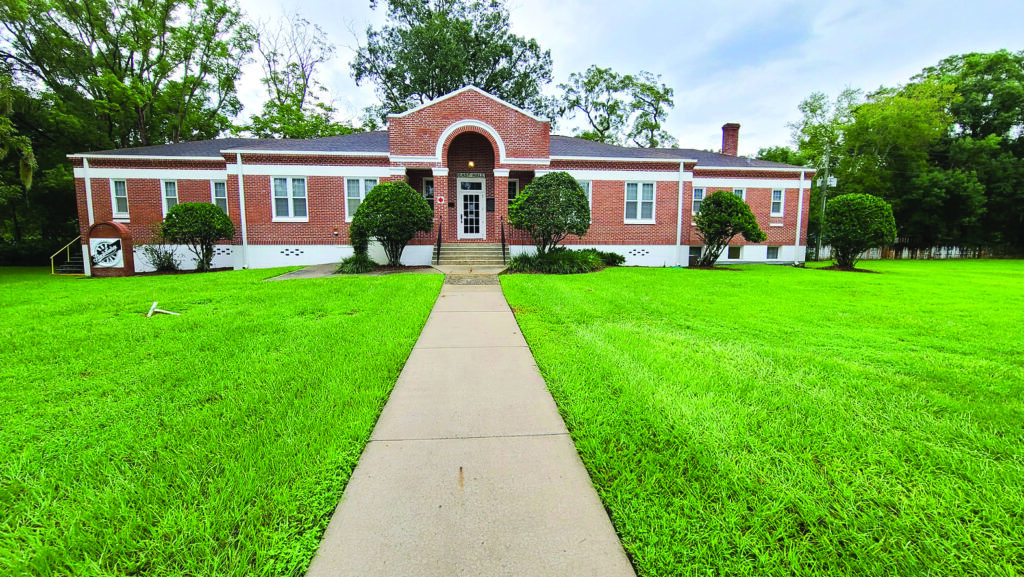
The Marion County Museum of History and Archaeology is shown in the McPherson Governmental Complex in Ocala, Fla. on Monday, Sept. 14, 2020. [Bruce Ackerman/Ocala Gazette] 2020.
Jim Jernigan’s (of Jim Jernigan Photography) son went and dug on the property, prior to the Seminole Feed Store being built, and found some of the bottles, said Landrum.
“When Jim Jernigan passed away, his son sold the collection, and someone bought it and gave it to us,” said Landrum.
The museum has a wide variety of collections, featuring artifacts and memorabilia from the prehistoric period to colonial times and to other eras, said Delk.
“We welcome donations to the extent that we have space available as long as they’re appropriate for display or to store in our archives,” said Delk. “We also take loans, if someone wants to loan something for a period of time for some of the revolving displays.”
The Marion County Museum of History and Archaeology is open Monday, Tuesday and Thursday through Saturday from 10am to 3pm.For more information, visit their website at www.marioncountyarchaeology.com.





